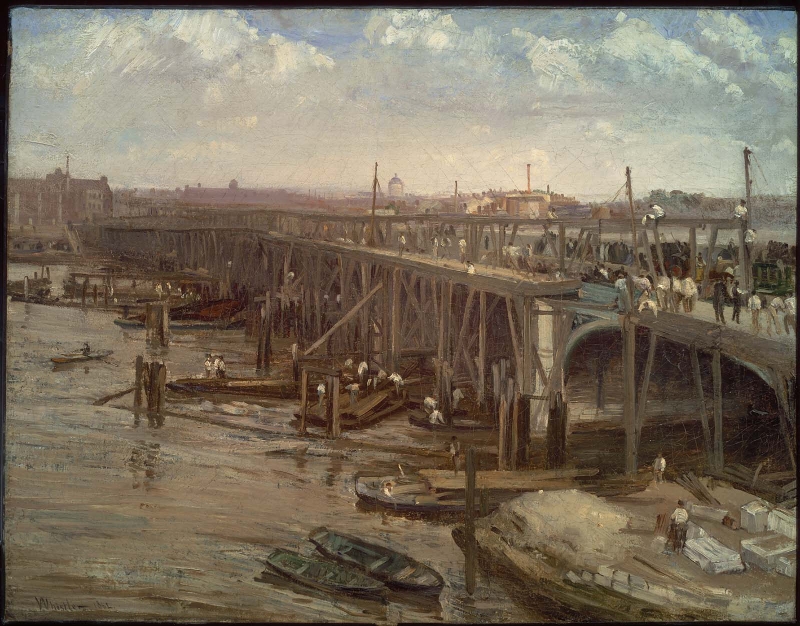Titles
Several possible titles have been suggested:
- 'Westminster Bridge' (1862, Whistler). 1
- 'The Last of Old Westminster' (1863, Royal Academy of Arts). 2
- 'Taking down scaffolding of Old Westminster Bridge' (1878, Whistler). 3
- 'Westminster Bridge ' (1892, Whistler). 4
- 'Westminster Bridge' (1898, Society of American Artists, New York). 5
- 'Old Westminster Bridge' and, in deluxe edition, 'The Last of Old Westminster' (1905, ISSPG, London). 6
- 'Le vieux pont de Westminster. – (Old Westminster Bridge.)' (1905, Œuvres de James McNeill Whistler, Paris). 7
- 'La démolition des échafaudages du pont de Westminster' (1905, Léonce Bénédite). 8
- 'The Last of Old Westminster' (1980, YMSM). 9
'The Last of Old Westminster' is the preferred title.
Description
A cityscape, showing a bridge over a broad river, painted in horizontal format. From a massive stone pier on the right, the bridge rises gradually to the central span, then declines to the shore at far left. Wooden scaffolding encases the bridge, which is crowded with workers. Barges in the lower right foreground carry building materials, and there are narrow barges and skiffs on the river or navigating under the bridge to left. Along the far shore are large warehouses, and, in the distance, several large buildings, two with domes, others with tall chimneys. Beyond the bridge, at right, the river begins to curve away into the distance. The water is grey and brown, the sky pale blue with clouds touched with sunlight.
Site
The river Thames in London. Whistler's 1863 title was The Last of Old Westminster but, according to reports in The Times, the Old Westminster Bridge was rapidly passing from view in October 1860, and virtually all of it had been removed by late April 1861. The subject is in fact the new Westminster Bridge, built on the same alignment while the old bridge was being taken down. Traffic was passing over it by October 1860 (in the painting, cabs are seen on the west side of the bridge). However, scaffolding was still in place at the end of December 1861, and remained so after the bridge was opened on 25 May 1862. The timbering on the new Westminster Bridge was removed early in July 1862. 10
According to Arthur Severn (1842-1931), quoted by the Pennells, Whistler painted this view from the rooms of Walter Severn (1830-1904), in Manchester Buildings, on the site of the present New Scotland Yard. 11
Kelly's London Postal Directory for 1862 lists Arthur Severn, his brother Walter, and their sister Mary, all artists, living at 83A Ecclestone Square, off the Belgrave Road, London S.W. No-one was actually listed as living at 11 Manchester Buildings until 1864, when John Baldry Redman, a civil engineer, lived there. However, Kelly's Directories were not entirely accurate (and indeed in 1863 they brought out a second edition to remedy errors), so Severn might have had rooms or an office there.
Notes:
1: Whistler to G. A. Lucas, [19 December 1862], GUW #09189.
2: 95th Exhibition of the Royal Academy of Arts, London, 1863 (cat. no. 352).
3: Whistler to J. A. Rose, [November 1878], GUW #08784.
4: Whistler to D. C. Thomson, [4/11 January 1892], GUW #06795.
5: Twentieth Annual Exhibition of the Society of American Artists at the Galleries of the American Fine Arts Society, New York, 1898 (cat. no. 35); likewise in Oil Paintings, Water Colors, Pastels and Drawings: Memorial Exhibition of the Works of Mr. J. McNeill Whistler, Copley Society, Boston, 1904 (cat. no. 34).
6: Memorial Exhibition of the Works of the late James McNeill Whistler, First President of The International Society of Sculptors, Painters and Gravers, New Gallery, Regent Street, London, 1905 (cat. no. 35) and Paris 1905 (cat. no. 56).
7: Œuvres de James McNeill Whistler, Palais de l'Ecole des Beaux-Arts, Paris, 1905 (cat. no. 56).
8: Bénédite 1905 A [more] , in vol. 33, repr. p. 503.
9: YMSM 1980 [more] (cat. no. 39).
10: The Times, 27 September 1860, 'New Westminster Bridge', The Times, 26 May 1862, p. 9; and The Times, 4 July 1862.
Last updated: 4th June 2021 by Margaret






